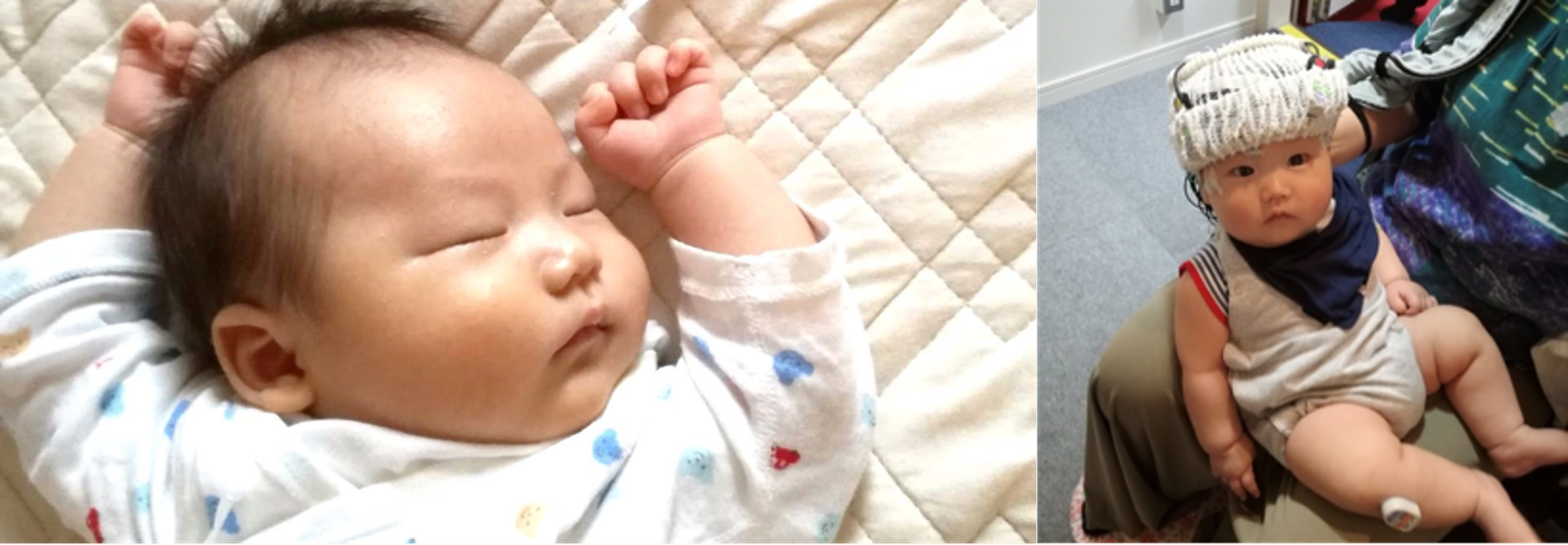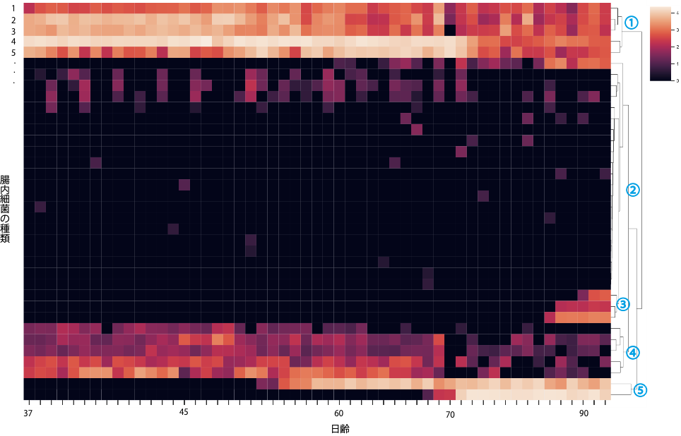Developmental Science of Sleep, Crying, and Eating
About this project
Sleeping, crying, and eating are all activities that occur from the onset of development. For instance, it is well known that sleep and crying comprise a significant proportion of the day during the neonatal period. In the process of gradually reducing sleep and crying time, as well as acquiring various motor and cognitive abilities post-birth, what underlying neural and physiological developments drive this process and how do they interact with internal bodily systems (e.g. intestinal microbiota)? The Developmental Science division at Cedep is investigating these queries by collecting behavioral and physiological data on the body and brain, primarily in infants, utilizing techniques such as computational modeling.
Development of sleep

In the case of adult sleep, it is well-established that it can be divided into two distinct states: REM and non-REM sleep. However, it is still not fully understood when infants begin to exhibit sleep patterns similar to those of us. Traditional behavioral markers, such as sleeping and waking times, which have been conventionally employed to assess infant sleep, are insufficient to evaluate the qualitative development of infant sleep.
To shed light on the quantitative and qualitative changes in the nature of "sleep" during this period, we have conducted a multifaceted study on the maturation of brain functional networks during sleep in neonatal to 3-month-old infants. This study includes evaluating brain activity and functional networks using EEG and near infrared spectroscopy (NIRS), assessing peripheral physiological activity, and observing body movements (startle movements, twitches, etc.) (Collaborative research with Associate Professor Ryoya Saji, Tamagawa University, and Associate Professor Hirotaka Gima, Tokyo Metropolitan University).
Selected Publications
- Shinya, Y., Gima, H., Watanabe, H., & Taga, G. (2022). Heart rate variability associated with body movements during sleep in early infancy. Paper presented at the 22nd Annual Meeting of the Japanese Society of Baby Science, Jichi Medical University, Tochigi, Japan.
- Akita, K., Endo, T., Watanabe, H., & Taga, G. (Eds.). (2021). Developmental science of infants and young children. In Frontrunner in Developmental Nursing Practice and Policy Studies (Vol. 3). Chuohoki Publishing.
- Akita, K. (Supervisor), Endo, T., Watanabe, H., & Taga, G. (Eds.). (2019). Infant Development and Care: Eating, Sleeping, Playing, and Connecting. Asakura Shoten.
- Aritake, S. (2018). Infant sleep and development. Psychological Review, 60(3), 216-229.
Development of crying

Crying, like sleep, is a common sight for caregivers and nursery staff, and is considered a typical behavior among infants. However, the kinetic and physiological processes underlying infant crying, as well as its correlation with subsequent sound production, such as the acquisition of language and musicality, remain largely unexplored.
Our research endeavors to investigate the vocalizations and limb movements that occur during infant crying and their relationship to physiological systems, such as autonomic nervous activity. Additionally, we are conducting acoustic analysis of early developmental crying and utilizing advanced techniques, such as deep learning (AI), to estimate the emergence of acoustic features of the mother tongue and their correlation with later language and musical development. (Collaborative research with Associate Professor Taiji Ueno of Tokyo Woman's Christian University and Associate Professor Shinya Fujii of Keio University)
Prior studies have demonstrated that infants undergo significant changes in both motor and physiological aspects prior to and following crying episodes (Shinya, Watanabe, & Taga, 2018; 2019), and that the acoustic features of crying in early development predict language development in late infancy (Shinya et al. 2017; Shinya, 2021).
Selected Publications
- Ishii, Y., & Shinya, Y. (2021). Positive emotions have different impacts on mood and sympathetic changes in crying from negative emotions. Motivation and Emotion, 45(4), 530–542.
- Shinya, Y. (2021). Reconsidering the developmental significance of crying: An examination of the acoustic characteristics of crying in the early developmental stage and its relation to language and social development. Baby Science, 20, 22-45.
- Shinya, Y. (2021). Investigating the role of autonomic nervous system functions in infant crying. Journal of Physiological Psychology and Psychophysiology, 39(2), 99-99.
- Shinya, Y., Watanabe, H., & Taga, G. (2019). Covariation of spontaneous movements and vocalizations in early infant crying: investigating the role of autonomic state. 52nd Annual meeting of International Society for Developmental Psychobiology, Chicago. (poster)
- Akita, K. (Supervisor), Endo, T., Watanabe, H., Taga, G. (Eds.), (2019). Infant Development and Care: Eating, Sleeping, Playing, and Connecting. Asakura Shoten. Shinya, Y. Chapter 3: Play 'Crying.'
- Shinya, Y., Watanabe, H., & Taga, G. (2018). Spontaneous Movements and Autonomic Nervous Activity during Crying in 3-month-old Infants. XXI Biennial International Conference on Infant Studies, Philadelphia. (poster)
- Shinya, Y., Kawai, M., Niwa, F., Imafuku, M., & Myowa, M. (2017). Fundamental Frequency Variation of Neonatal Spontaneous Crying Predicts Language Acquisition in Preterm and Term Infants. Frontiers in Psychology, 8, 711–717.
Development of eating (intestinal microbiota)

Eating, in conjunction with the series of physiological processes that encompass digestion, absorption, metabolism, and excretion, is a fundamental activity that underpins the maintenance of life. In recent years, it has become increasingly clear that there exists a strong interaction between the gut and the brain through the autonomic nervous system, neurotransmitters, and hormones. However, the intricacies of how the intestinal microbiota, which is sterile during the fetal period, interacts with the mother, other organisms, and the environment after birth, and how these dramatic changes in the intestinal environment relate to brain and behavioral development, remain largely unknown.
To shed light on these questions, we are currently collecting data on the intestinal microbiota during the first two years of life and using mathematical methods to investigate the dynamics and mechanisms at play. Additionally, we plan to explore the relationship between the formation of the intestinal microbiota and behavioral development, such as eating, sleeping, and crying during infancy, as well as its relationship to the formation of functional brain networks.
Selected Publications
- Kuriyama, Y., Naka, I., Watanabe, H., Taga, G., & Ohashi, J. (2022). Changes in the intestinal microflora during infancy. Paper presented at the 76th Annual Meeting of the Japan Society for Anthropology and the 38th Annual Meeting of the Primate Science Society of Japan, Kyoto, P-37.
- Akita, K. (Supervisor), Endo, T., Watanabe, H., & Taga, G. (Eds). (2019). Infant Development and Childcare: Eating, Sleeping, Playing, and Connecting. Asakura Shoten. Taga, G. Chapter 2: Eating 'From Gut to Brain'.



